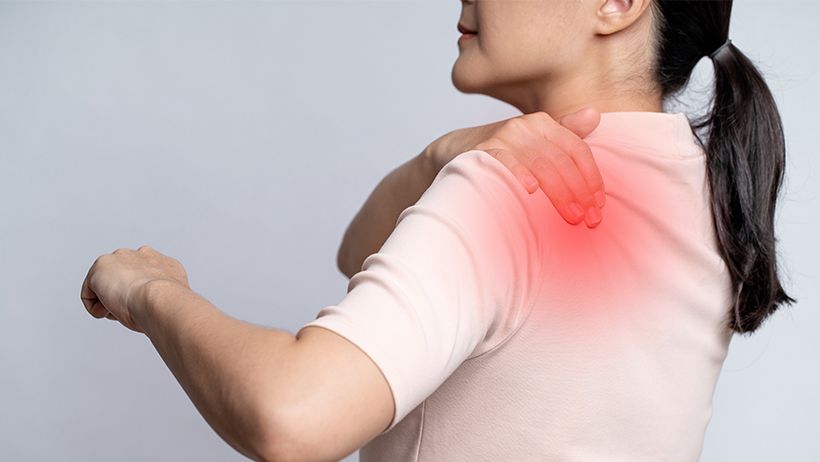Shoulder pain is a common ailment that can significantly impact your daily life. Whether it's a dull ache or a sharp, shooting sensation, this discomfort can make even the simplest tasks feel like a challenge. The shoulder joint is a complex structure, comprising bones, muscles, tendons, and ligaments, all working together to provide a wide range of motion. When any of these components are compromised, it can lead to pain and limited mobility.

Causes of Shoulder Pain
Shoulder pain can stem from a variety of factors, ranging from acute injuries to chronic conditions. Here are some of the most common causes:
• Rotator Cuff Injuries: The rotator cuff is a group of four muscles and tendons that stabilize the shoulder joint. Overuse, repetitive motions, or acute trauma can lead to inflammation, tendinitis, or even tears in these structures, resulting in pain and limited mobility.
• Arthritis: Both osteoarthritis and rheumatoid arthritis can affect the shoulder joint, causing inflammation, stiffness, and pain. As the cartilage deteriorates, the bones can rub against each other, leading to further discomfort and joint damage.
• Frozen Shoulder (Adhesive Capsulitis): This condition is characterized by a gradual onset of stiffness and pain in the shoulder joint, often due to inflammation and the formation of scar tissue around the joint capsule.
• Bursitis: The bursa is a fluid-filled sac that cushions the joints, including the shoulder. When these bursa become inflamed (bursitis), it can cause significant pain and swelling in the affected area.
•Tendinitis: Tendons are the fibrous cords that connect muscles to bones. Overuse or repetitive motions can lead to inflammation and irritation of the tendons in the shoulder, a condition known as tendinitis
Symptoms of Shoulder Pain
The symptoms of shoulder pain can vary depending on the underlying cause, but some common signs to watch out for include:
• Pain: This can range from a dull ache to a sharp, shooting pain, and may be localized or radiate down the arm or up into the neck.
• Stiffness: Restricted mobility and difficulty moving the shoulder joint is a common symptom, particularly in conditions like frozen shoulder or arthritis.
• Weakness: Injuries or conditions affecting the rotator cuff muscles can lead to weakness and difficulty lifting or reaching with the affected arm.
• Swelling: Inflammation in the shoulder joint or surrounding tissues can cause visible swelling and tenderness in the area.
•Grinding or Clicking: These sensations may occur when moving the shoulder joint, indicating potential damage or instability.
What Are Hyaluronic Acid Injections?
Hyaluronic acid is a naturally occurring substance found in the body's connective tissues, including the fluid that lubricates joints. As we age, the body's production of hyaluronic acid decreases, leading to a reduction in joint lubrication and potential cartilage damage.
Hyaluronic acid injections involve injecting a synthetic form of hyaluronic acid directly into the affected joint. This procedure aims to supplement the natural lubrication in the joint, reducing friction and improving mobility.
These injections are minimally invasive and can be performed in an outpatient setting, typically under local anesthesia or with a numbing agent. The procedure itself is relatively quick, taking only a few minutes to complete.
Relief That Lasts - The Durolane Advantage
Durolane is a stabilized form of hyaluronic acid that has been cross-linked, allowing it to remain in the joint for a more extended period. This innovative technology means that a single injection can provide relief for up to six months or longer, significantly reducing the need for frequent follow-up injections.
Additionally, Durolane has been shown to have a higher molecular weight and increased elasticity compared to other hyaluronic acid products. These properties contribute to its ability to better mimic the natural lubricating properties of the joint fluid, potentially leading to more effective pain relief and improved joint function.
What to Expect During Hyaluronic Acid Injection Treatments
The process of receiving hyaluronic acid injections for shoulder pain is generally straightforward and minimally invasive. Before undergoing the procedure, our clinic will conduct a thorough evaluation to determine the underlying cause of your shoulder pain and assess your suitability for hyaluronic acid injections.
The procedure takes about 15 minutes. First, doctors thoroughly numb the shoulder area with a local anesthetic. Then, they insert a small needle into the shoulder joint space using imaging guidance.
Slowly, they inject Durolane to coat the joint and fill the space. After injecting, they remove the needle and apply a bandage. After a brief recovery period, most patients can resume normal activities on the same day with little or no downtime. You may feel mild discomfort, which resolves within a day or two.
Hyaluronic Acid Shoulder Injections FAQs
The procedure requires almost no downtime. You can usually return to regular activities right after.
Schedule a Consultation
for Long-Term Shoulder Pain Relief
If you're experiencing persistent shoulder pain that is interfering with your daily activities, contact ReAlignMed. Our experienced professionals will work closely with you to determine if Durolane is the right solution for your needs.
Schedule a consultation and take the first step towards regaining your mobility and quality of life, Visit ReAlignMed at our office in Chicago, Illinois. Call 773-665-4400 to schedule an appointment today.





